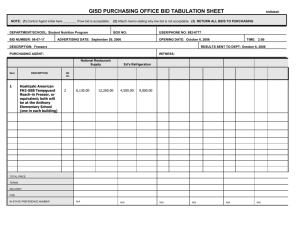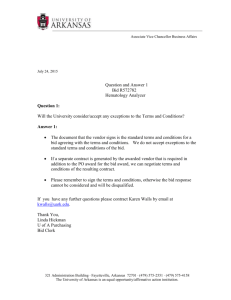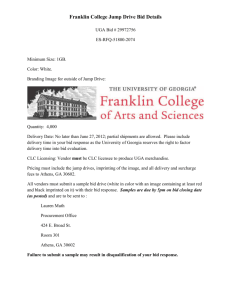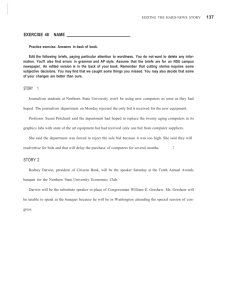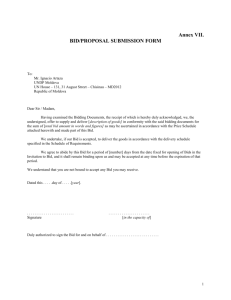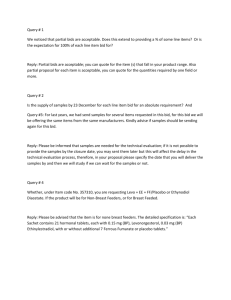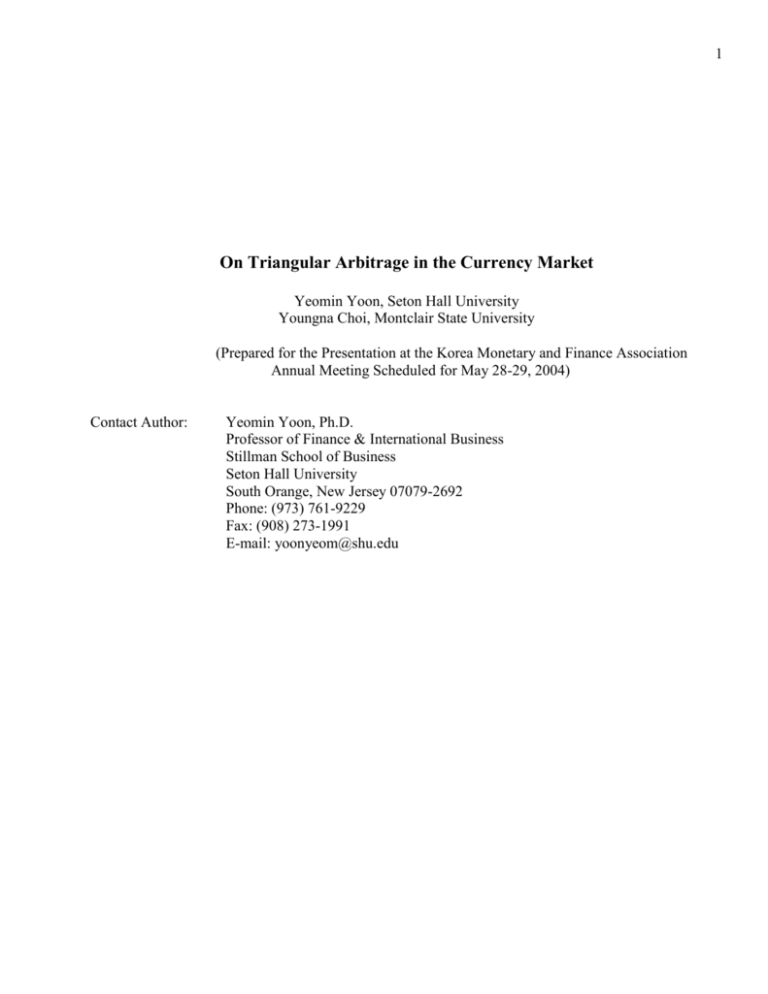
1
On Triangular Arbitrage in the Currency Market
Yeomin Yoon, Seton Hall University
Youngna Choi, Montclair State University
(Prepared for the Presentation at the Korea Monetary and Finance Association
Annual Meeting Scheduled for May 28-29, 2004)
Contact Author:
Yeomin Yoon, Ph.D.
Professor of Finance & International Business
Stillman School of Business
Seton Hall University
South Orange, New Jersey 07079-2692
Phone: (973) 761-9229
Fax: (908) 273-1991
E-mail: yoonyeom@shu.edu
2
On Triangular Arbitrage in the Currency Market
Typical international finance textbooks explain the triangular arbitrage process via
numerical examples, using a single quote per bank, i.e., assuming no bid and asked
spread or no transaction cost. In the real world, however, banks always use bid and
asked prices when they announce their currency quotations and this makes the
explanation or derivation of the arbitrage conditions rather complicated. This paper
provides a rigorous but simple derivation of triangular arbitrage conditions based on bid
and asked prices.
INTRODUCTION
Until recently, the pervasive practice among bank dealers was to quote all currencies against the U.S.
dollar for trading among them. Now, however, a growing percentage of currency trades do not involve
the dollar [Shapiro, 2003]. For example, German or British banks may quote the euro in terms of the
pound sterling. Currency traders are continually alert to the possibility of taking advantage of exchange
rate inconsistencies in three different money centers, through “triangular currency arbitrage”
transactions.
Typical international finance textbooks explain the triangular arbitrage process via numerical
examples, using a single quote per bank, i.e., assuming no bid and asked spread or no transaction cost.1
[Eiteman, 2004; Levtich, 1998; Madura, 2003, Shapiro, 2003; Eaker, Fabozzi and Grant, 1996; Grabbe,
1991; Kim and Kim, 1999]. Such numeric examples typically compare market rates with inter-bank
cross rates to determine when arbitrage (producing a positive profit) is possible, and under such a
simplifying assumption, the arbitrage condition is rather simple. In the real world, however, banks
always use bid and asked prices2 when they announce their currency quotations and this makes the
explanation or derivation of the arbitrage conditions rather complicated. The purpose of this paper is to
3
provide a rigorous but simple derivation of triangular arbitrage conditions. The authors have not found
such a derivation in any textbook or academic journal.
ARBITRAGE CONDITION WITH NO TRANSACTION COST
In order to facilitate the exposition, we start out with simple numerical examples which ignore bid and
asked prices (i.e., assume zero transaction cost) and assume that a fourth party trader can either buy or
sell currencies at the market rates quoted below (see the second columns of Tables 1 and 2) by three
banks, i.e., Bank A in New York, Bank B in London, and Bank C in Frankfurt, respectively. (These are
typical textbook examples. The market rate may be a mid-point between bid and asked prices.)
Table 1. Market Rates and Cross Rates between Banks: Numerical Example 1
Cross Rates
Market Rates
Overvaluation or Undervaluation
between Banks
Bank A quotes
$1.5422/£
$1.5402/£
£ is overvalued; $ is undervalued.
Bank B quotes
£0.6006/€
£0.5998/€
€ is overvalued; £ is undervalued.
Bank C quotes
€1.0810/$
€1.0796/$
$ is overvalued; € is undervalued.
You are a fourth party, an American trader. If you start out with $1, how much triangular arbitrage
profit can you make? A useful first step to answer the question may be to derive cross rates between
banks. For example, one can derive the cross rate for Bank A by inverting the product of the quotes of
the other two banks (Bank B and Bank C) -- note the symmetry of units in quotations. The second step
is to determine, using the cross rate as a reference, which currency is overvalued or undervalued. In
order to make an arbitrage profit, all you have to do is to “buy low,” i.e., buy a currency undervalued in
terms of another currency, and “sell high,” i.e., sell a currency overvalued in terms of another currency.
Step 1: At Bank C, sell $1 and buy €1.0810.
4
Step 2: At Bank B, sell €1.0810 and buy £0.6006 x 1.0810.
Step 3: At Bank A, sell £0.6006 x 1.0810 and buy $1.5422 x 0.6006 x 1.0810 = $1.001271.
You started with $1 (or $1,000,000) and ended up with $1.001271 (or $1,001,271), making a triangular
arbitrage profit of $0.001271 (or $1,271).
Table 2. Market Rates and Cross Rates between Banks: Numerical Example 2
Cross Rates
Market Rates
Overvaluation or Undervaluation
between Banks
Bank A quotes
$1.5402/£
$1.5725/£
£ is undervalued; $ is overvalued.
Bank B quotes
£0.5885/€
£0.6008/€
€ is undervalued; £ is overvalued.
Bank C quotes
€1.0806/$
€1.1033/$
$ is undervalued; € is overvalued.
Table 2 displays different market rates under which the currencies deemed “overvalued”
(“undervalued”) in Table 1 are now “undervalued” (“overvalued”). For example, at Bank A, the pound
sterling is undervalued, and the U.S. dollar overvalued. Again, if you start out with $1, how much
triangular arbitrage profit can you make?
Step 1: At Bank A, sell $1 and buy £
1
.
1.5402
Step 2: At Bank B, sell £
1
1
1
and buy €
.
1.5402
1.5402 0.5885
Step 3: At Bank C, sell €
1
1
1
1
1
1
and buy $
=$
1.5402 0.5885
1.5402 0.5885 1.0806
0.97946416
= $1.020966.
You started with $1 (or $1,000,000) and ended up with $1.020966 (or $1,020,966), making a triangular
arbitrage profit of $0.020966 (or a whopping $20,966).
5
Using general symbols, the above process can be explained as follows:
Table 3. Market Rates and Cross Rates Using General Symbols
Cross Rates
Market Rates
between Banks
1
$
/£
Bank A quotes
$A/£
BC
1
£
/€
Bank B quotes
£B/€
CA
1
€
/$
Bank C quotes
€C/$
AB
Note that $A/£ denotes Bank A’s price of the pound sterling in terms of the U.S. dollar, etc.
Step 1: At Bank C, sell $1 and buy €C.
Step 2: At Bank B, sell €C and buy £BC.
Step 3: At Bank A, sell £BC and buy $ABC.
You started with $1 and ended up with $ABC. So, as long as ABC > 1, you can make an arbitrage
profit. (If ABC = 1, no arbitrage opportunity or zero profit.) Note that, due to the symmetry of the units
for market rates, given the market rate of one bank for one currency, the corresponding cross rate of the
same currency is the reciprocal of the product of the other two bank’s market rates (for example, A vs.
1/BC, B vs. 1/CA). Therefore, ABC is the ratio of the market rate of one currency to its cross rate, and
this property remains valid regardless of the currency and bank. This implies that ABC > 1 implies that
the market rates are greater than the cross rates for all three banks and for all three currencies.
Alternatively, you can do transactions in the following order:
6
Step 1: At Bank A, sell $1 and buy £
1
.
A
Step 2: At Bank B, sell £
1
1
and buy €
.
AB
A
Step 3: At Bank C, sell €
1
1
and buy $
.
AB
ABC
As long as $
1
>$1, or ABC < 1, you can make an arbitrage profit. Due to the symmetry of the
ABC
units for market rates, ABC < 1 implies that the market rates are smaller than the cross rates for all three
banks and for all three currencies.
Employing a decision tree, the above steps can be explained in a compact manner as shown by Figure 1.
7
Figure 1. A Decision Tree for Determining Arbitrage Conditions:
With Zero Transaction Cost
Step 1
Step 2
At Bank B
Sell €C, buy £BC
At Bank C
Sell $1, buy €C
Step 3
At Bank A
Sell £BC, buy $ABC
At Bank B
At Bank C
C
Sell €C, buy $ =$1
C
Sell £BC, buy €
BC
B
= €C
→ Abandon
→ Abandon
$1
At Bank A
At Bank A
Sell $1, buy £ 1
A
Sell £
1
, buy $ A $1
A
A
→ Abandon
At Bank B
Sell £ 1 ,
A
buy € 1
AB
At Bank B
B
Sell € 1 , buy£
=£1
AB
A
AB
→ Abandon
At Bank C
Sell € 1 , buy $ 1
AB
ABC
ARBITRAGE CONDITIONS BASED ON BID AND ASKED PRICES: A REAL WORLD CASE
Real world market rates (bid and asked prices) quoted by banks and corresponding cross rates between
banks can be expressed, using general symbols, as shown by Table 4 below.
8
Table 4. Market Rates and Cross Rates in terms of Bid and Asked Prices
Market Rates
Cross Rates between Banks
Bid
Asked
Bid
Asked
1
1
$
/£
$
/£
Bank A quotes
$Ab/£
$Aa/£
Ba C a
Bb C b
1
1
£
/€
£
/€
Bank B quotes
£Bb/€
£Ba/€
C a Aa
C b Ab
1
1
€
/$
€
/$
Bank C quotes
€Cb/$
€Ca/$
Aa Ba
Ab Bb
Note that $Ab/£ denotes Bank A’s bid price of the pound sterling in terms of the U.S. dollar, while
$Aa/£ means Bank A’s asked price of the pound sterling in terms of the U.S. dollar, etc.
Claim: There is an arbitrage profit opportunity if AbBbCb > 1 or AaBaCa < 1. Equivalently, there is no
arbitrage opportunity if AbBbCb ≤1 ≤ AaBaCa .
Note: Because of the relation between the bid and asked prices, Ab< Aa, Bb<Ba, and Cb<Ca, either
AaBaCa > AbBbCb ≥1 or AbBbCb < AaBaCa ≤1. AbBbCb = AaBaCa = 1 implies there is neither loss nor gain.
If you start out with $1, there are two choices in Step 1. You either sell the $1 and buy €Cb at Bank C
or sell the $1 and buy £ 1 at Bank A. Steps 2 and 3 are explained in a similar manner, employing a
Aa
decision tree (see Figure 2 below). When you make two consecutive transactions at the same bank, (e.g.
in Step 2 at Bank C, sell €Cb and buy $ Cb at Bank C), you end up with less fund than you started at
Ca
that bank (no wonder, for you have to pay the transaction cost), you should abandon the project.
9
Figure 2. A Decision Tree Determining Triangular Arbitrage Conditions:
With Bid and Asked Prices
Step 1
Step 2
Step 3
Step 3
At Bank B
Sell €Cb, buy £BbCb
At Bank C
Sell $1, buy €Cb
At Bank B
At Bank C
Sell €Cb, buy $
At Bank A
Sell £BbCb, buy $AbBbCb
Cb
<$1
Ca
→Abandon
Sell £BbCb, buy € Bb Cb €Cb
Ba
→ Abandon
$1
At Bank A
At Bank A
Sell $1, buy £ 1
Aa
Sell £
1
, buy $ Ab $1
Aa
Aa
→ Abandon
At Bank B
Sell £ 1 ,
Aa
buy € 1
Aa Ba
At Bank B
Sell € 1 , buy£ Bb < £ 1
Aa B a
Aa
Aa Ba
→ Abandon
At Bank C
1
Sell € 1 , buy $
Aa B a
Aa Ba C a
You end up with $AbBbCb if you sell the initial $1 at Bank C, or with $
1
if you sell it at Bank
Aa Ba C a
A. Thus, in order to make a profit, you should end up with either $AbBbCb > $1 (i.e., AbBbCb > 1) or
$
1
> $1 (i.e., AaBaCa < 1). Hence, you should do the following: If AbBbCb > 1, do transactions at
Aa Ba C a
Bank C, B, A order (upper branch), whereas if AaBaCa < 1, do transactions at Bank A, B, C order (lower
branch).
10
Note that AbBbCb > 1 implies Ab >
1
1
1
, Bb >
, Cb >
, which, in turn, implies that the bid
Bb Cb
Cb Ab
Ab Bb
market rates are greater than the asked cross rates for all three banks and for all three currencies. The
converse is obvious. Therefore, we conclude that there is an arbitrage opportunity if and only if the bid
market rates are greater than the asked cross rates for all three currencies and for all three banks.
Similarly, AaBaCa < 1 implies Aa <
1
1
1
, Ba <
, Ca <
and vice versa, which again implies
Ba Ca
C a Aa
Aa Ba
that there is an arbitrage opportunity if and only if the asked market rates are smaller than the bid cross
rates for all three currencies and for all three banks.
By way of numerical examples shown by Tables 5, 6 and 7 below, the arbitrage conditions and the
three steps to be taken by the arbitrager may be explained more easily.
Table 5. Numerical Example I for Bid and Asked Rates
Market Rates
Cross Rates (between banks)
Bid
Asked
Bid
Asked
Bank A’s quotes
$1.5417/£
$1.5427/£
$1.5390/£
$1.5415/£
Bank B’s quotes
£0.6004/€
£0.6008/€
£0.5994/€
£0.6003/€
Bank C’s quotes
€1.0805/$
€1.0815/$
€1.0789/$
€1.0803/$
Since AbBbCb = 1.5417 x 0.6004 x 1.0805 = 1.000150 > 1 – implying that all bid market rates are
greater than all asked cross rates –, you follow the upper branch of the decision tree, i.e., sell the
(overvalued) dollar for the (undervalued) euro at Bank C, sell the euro for the pound sterling at Bank B,
and sell the pound sterling for the dollar at Bank A, ending with a profit of $0.00015 ($150) if you
started with $1 ($1,000,000).
11
Table 6. Numerical Example II for Bid and Asked Rates
Market Rates
Cross Rates (between banks)
Bid
Asked
Bid
Asked
Bank A’s quotes
$1.5397/£
$1.5407/£
$1.5712/£
$1.5738/£
Bank B’s quotes
£0.5883/€
£0.5887/€
£0.6004/€
£0.6013/€
Bank C’s quotes
€1.0801/$
€1.0811/$
€1.1025/$
€1.1040/$
Since AaBaCa = 1.5407 x 0.5887 x 1.0811 = 0.980569 < 1 – implying that all asked market rates are
smaller than all bid cross rates –, you follow the lower branch of the decision tree, i.e., sell the
(overvalued) dollar for the (undervalued) pound sterling at Bank A, sell the pound sterling for the euro at
Bank B, and sell the euro for the dollar at Bank C, ending with a profit of $0.019816 ($19,816) if you
started with $1 ($1,000,000).
Table 7. Numerical Example III for Bid and Asked Rates
Market Rates
Cross Rates (between banks)
Bid
Asked
Bid
Asked
Bank A’s quotes
$1.5402/£
$1.5442/£
$1.5351/£
$1.5454/£
Bank B’s quotes
£0.5997/€
£0.6015/€
£0.5980/€
£0.6017/€
Bank C’s quotes
€1.0790/$
€1.0830/$
€1.0766/$
€1.0827/$
Since AbBbCb = 1.5402 x 0.5997 x 1.0790 = 0.9966 < 1, no arbitrage profit can be made. Alternatively,
since AaBaCa = 1.5442 x 0.6015 x 1.0830 = 1.0059 > 1, no arbitrage profit can be made, either. Note
that the quotations used in Table 1 above are mid-points of the bid and asked prices in Table 7. Using
the quotes of Table 1, you can make a triangular arbitrage profit. Given the bid and asked quotes of
Table 7, however, the transaction cost (imposed by the spread between bid and asked prices) wipes out
any potential profit that may be realized in the zero-transaction-cost world. In fact, the spreads between
bid and asked prices (transaction costs) imposed by the three banks are so wide that you would end up
with a loss regardless of which branch of the decision tree you followed.
CONCLUSION
12
In a world of zero transaction cost (typical textbook case), one can make a triangular arbitrage profit if
the product of the three market rates (assuming the rates are quoted “symmetrically”) is either greater or
smaller than 1. If such a product equals 1, the arbitrager ends up with a zero profit.
If foreign exchange market rates are quoted in terms of bid and asked prices (the real world case), a
triangular arbitrage profit can be made if (i) the product of the three bid market rates is greater than 1
(which, in turn, is equivalent to stating that all bid market rates are greater than all asked cross rates) or
(ii) the product of the three asked market rates is smaller than 1 (which, in turn, is equivalent to stating
that all asked market rates are smaller than all bid cross rates). Moreover, cases (i) and (ii) are mutually
exclusive. If either the product of the three bid market rates or the product of the three asked market
rates is equal to 1, the arbitrager ends up with a zero profit.
1
Levi (1996) and Eun and Resnick (2004) utilize bid and asked prices when they discuss the triangular arbitrage transactions.
However, unlike this paper, they focus on numerical examples without explicitly deriving arbitrage profit conditions.
2
Dealers in financial markets including the foreign exchange market set their spreads between bid and asked prices to
maximize their profits. Their spreads must be wide enough to allow them to recover their costs of doing business. Otherwise,
they will not be profitable. Their spreads cannot be so wide, however, that no one will trade with them. For a detailed
discussion on bid/asked spreads, see Harris (2003, pp. 297-321).
REFERENCES
Eaker, Mark R., Frank J. Fabozzi, and Dwight Grant, International Corporate Finance (Orlando, 1996),
Dryden press,112-113.
Eiteman, David K., Arthur I. Stonehill, and Michael H. Moffett, Multinational Business Finance
(New York, 2004), 10th Edition, Pearson Addison Wesley, 86-87.
13
Eun, Cheol S. and Bruce G. Resnick, International Financial Management (New York, 2004),
3rd Edition, Irwin McGraw-Hill, 87-89.
Harris, Larry, Trading and Exchanges: Market Microstructure for Practitioners (Oxford, 2003), Oxford
University Press, 297-321.
Grabbe, J. Orlin, International Financial Markets (New York, 1991), 2nd Edition, Elsevier, 70.
Kim Suk H. and Seung H. Kim, Global Corporate Finance: Text and Cases (Mass, 1999), 4th
Edition, Blackwell,142-143.
Levi, Maurice D., International Finance (New York, 1996), 3rd Edition, McGraw-Hill, 48-54.
Levich, Richard M., International Financial Markets : Prices and Policies (New York, 1998),
Irwin McGraw-Hill, 76.
Madura, Jeff., International Financial Management (Mason, Ohio, 2003), 7th Edition, Thomson
South Western, 212-214.
Shapiro, Alan C., Multinational Financial Management (New York, 2003), 7th Edition, John
Wiley & Sons, 254-255.


